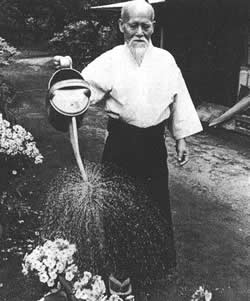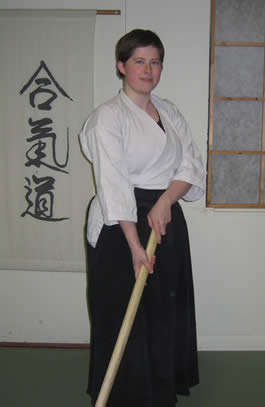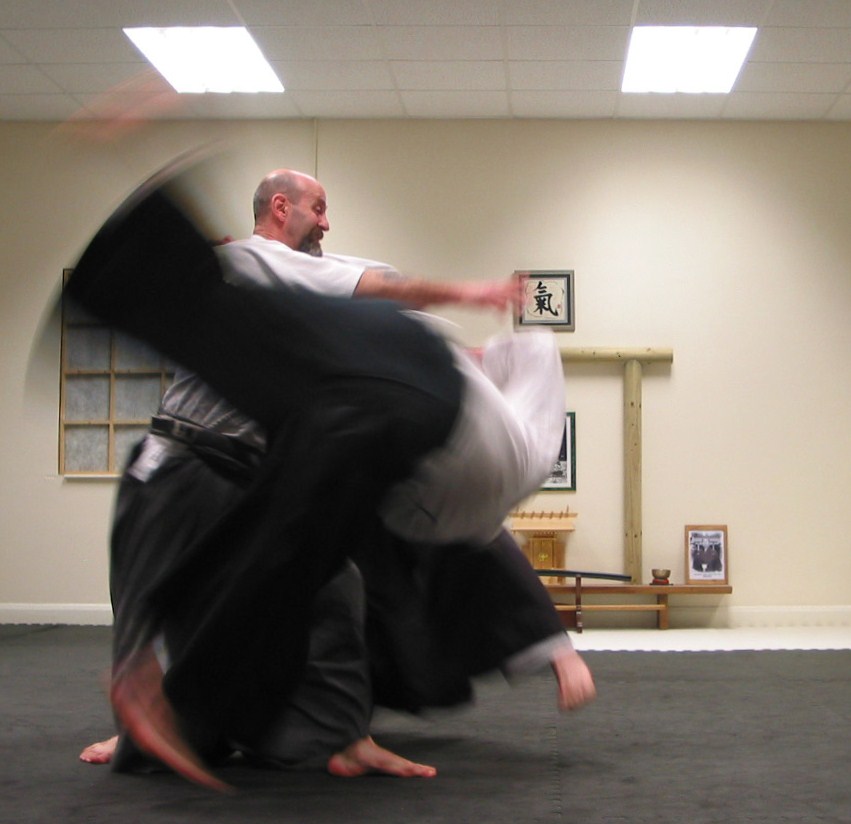Positive Health Online
Your Country

Physical and Spiritual Transformation - Principles of Aikido
by Shantelle Svarc & Bob Willmington(more info)
listed in chi energy martial arts, originally published in issue 171 - June 2010
Aikido is a unique martial art in that it can be practised without regard to size, strength or gender. It works because it does not seek to fight with the attacker; instead, it emphasizes removing oneself from the line of attack, using curves and spirals to unbalance the partner, with a variety of throws or pins to finish the technique.

Morihei Ueshiba
The importance of Aikido lies in it being a form of somatic education, which focuses on the interactions of posture, movement, emotion, thought, self concept and cultural values. In essence, how the mind can have a positive influence the body and vice verse.
A twentieth century martial art, created in Japan by Morihei Ueshiba, Aikido can be translated as 'The Art of Peace'. It places its emphasis not only on performing the physical techniques of the art, but on the philosophy behind them:
"To injure an opponent is to injure yourself.
To control aggression without inflicting injury is the Art of Peace."
Training with the Master, John Stevens, pg 125.
History
Born December 14th, 1883, Morihei Ueshiba was a premature, frail and sickly child. His teenage years were spent strengthening his body and mind, through working at the fishing docks and studying the elaborate rituals, mystical chants and meditation techniques of esoteric Shingon Buddhism. Fiercely competitive, and driven to compensate for his small stature (five feet, two inches) he joined the Japanese military, and studied Goto-ha Yagyu Ryu Jujitsu along with sword, spear and jo fighting.
Many encounters throughout his life helped to soften his fierce and aggressive temperament, but none more so than Onisaburo Deguchi, a spiritual teacher of the Omoto-kyo religion. At the age of thirty seven, Ueshiba submersed himself in the study of Omoto-kyo, joining the community in Ayabe. It was here that he formed his first dojo in 1920, teaching mostly practical self defence techniques, whilst tirelessly maintaining his own intense training schedule.
Over the years, Ueshiba's training and teaching evolved into an ever greater sense of pacifism, the peak of which occurred in 1937 with the outbreak of war with China, and the United States in 1941. Acutely aware of the contradiction between Budo (martial arts) as a way of preserving life, and war which fostered nothing but death and destruction on a truly massive scale, he left his Tokyo Dojo in the hands of his son, Kisshomaru, and moved to a small farm in Iwama. In 1942, he formally named his art, Aikido, the Way of Harmony.
Ueshiba died on April 26th, 1969, aged eighty six years old.
Among his final words were "Aikido is for the entire world."
A Woman's Perspective: Shantelle's Story
As the average woman has less physical strength than the average man, most people would call women 'weak'. It is in fact this very 'weakness' that makes women particularly suited to the study of Aikido. Unable to physically force and muscle through the movements, more attention is paid to proper technique and alignment; proficiency is often acquired earlier than their male counterparts.

Shantelle Svarc
Because women are on average shorter and have a lower centre of gravity, they often find that they are well suited to this hip-oriented graceful martial art.
Students also begin to learn that 'female' is not synonymous with 'victim.' The practice of rolling and falling, and the repetition of techniques allows the student to develop trust in themselves, that they can in fact succeed. This inner strength is what transforms them from the mentality of a victim to one of confidence and stability.
My own love affair with Aikido began as a shy and tentative young woman. Just seventeen years old, I had some experience of the martial arts through studying Karate in my childhood years, but longed for a system that was more than competition and fighting. As a dancer, I was drawn to the graceful movements which saw two people become one cohesive body, but as a woman, I saw it as a path towards inner strength, towards clarity and peace.
"Failure is the key to success.
Each mistake teaches us something."
Training with the Master, John Stevens, pg 129.
A Man's Perspective: Bob's Story
One of the difficulties that men face when studying Aikido, is letting go of the preconception that physical strength is the way to make a technique work. This conditioning takes place at young age, and is hard to overcome. The real power of Aikido comes from a subtle combination of relaxation, correct body alignment, motion, stability and posture.

Bob WIlmington
From my own personal experience, coming to Aikido at a relatively late stage in my life, aged 51, and having suffered with the life long frustration of a dyslexic mind, I found Aikido difficult. However, working both the left and right sides of the body, and using repetition to build muscle memory, I found a gradual and marked improvement in my dyslexia, giving me the confidence to carry on. Ten years on, I can honestly recommend Aikido with its many benefits of which I have seen over and over again.
Having worked in the alternative therapy business for a number of years I have come across a variety of therapies and belief systems, and whilst Aikido is a very affective martial art, it also has therapeutic qualities. It grounds you into the present, breaks down the ego and gives you an opportunity to truly see yourself as you are. I have seen it turn people's lives around, giving them the confidence and trust to allow themselves to be themselves, rather than a preconceived image from others. If it needed a therapeutic label, it would be a therapy for the soul. Aikido is real and honest.
It is a genuine force for good, giving so much back to those who have the tenacity to study this wonderfully intelligent system.
It cannot be emphasized enough the importance in finding the right Sensei (teacher) for you. I was lucky in finding an inspirational Sensei, Paul Chambers, 6th Dan, who gave me the encouragement to keep on keeping on. His generosity of spirit epitomizes what Aikido is all about.
"The Art of Peace is to fullfil that which is lacking."
Training with the Master, John Stevens, pg 130.
Integration
Although Aikido can be taught as an isolated system, there are various other traditions that can be used to accentuate it's principles. Our own personal practice, introduced to us by our Sensei Paul Chambers, includes Sitting Meditation, Qi Gong and Tai Chi.

Sensei Paul Chambers photo credit Pat Farrell
Sitting meditation is deceptively simple. An awareness of the breath, relaxed and naturally flowing, grounds the student in the present, and a stillness in the mind begins to develop.
This leads on to the Qi Gong standing postures, 'Zhan Zhuang', physically much harder to perform than simply sitting, they require the student to maintain a relaxed posture even when raising the hands above the shoulders. Seen as static postures, practice will reveal the movement that occurs when the body returns to its natural state. The very act of breathing changes the body's centre of gravity from moment to moment, which is reflected in the minute muscle contractions and relaxations necessary to maintain an upright and balanced posture. There is movement within the stillness.
As a martial art, Tai Chi is very similar to Aikido, with circular, soft and flowing movements. The principles of a stable posture, relaxed body, and still mind are brought from a relatively static practice to one requiring constant, large scale changes in the body's positioning. It is important that these motions are carried out as slowly as possible, so that in every moment there is an awareness of where the body is and how it is being held.
Progression in Aikido necessitates a challenging of many Western cultural preconceptions about strength, competition and success. As the above are individual practices that share the same principles as Aikido, training can occur without the distraction of attempting to throw another person, or getting caught up in a fighting mind set.
"The weak can overcome the strong,
The supple can overcome the stiff."
The Spirit of Tai Chi, John Lash, pg 294.
Confidence, Trust and Self Discipline
Training works on a variety of levels. Physically, there is an increase in fitness, flexibility and endurance, but more importantly, there are a multitude of emotional and spiritual changes that can take place.
The nature of Aikido allows students to work together in a non competitive environment, with the aim of developing trust and consideration for their training partners. As each individual has a responsibility to look to the safety of their partner, self control and mutual respect are important qualities to develop. The Dojo becomes a community.
A frequent fear of students is that of looking foolish or silly when training, of being unable to effectively perform the techniques or of being intimidated by fellow students. Fortunately, every beginning student has these same fears. Training is not about competition or displays of ego, it does not require physical prowess and extremes of fitness.
We often begin a new activity with the mindset "I can't do this". Rolling presents another unique way of stepping back from the learning process (we are always told not to fall!), and we can always blame our uncooperative partner for our inability to perform techniques. However, for those that stick around for long enough, and practise with sincerity and openness, they will, without fail, find that Aikido is about a group of people coming together in a joyful and cooperative manner, to better themselves and the society in which we live.
One of Ueshiba's rules for training.
Etiquette and Ceremony
It is common for people to ask about the practice of ceremony in Aikido. In particular, many people are concerned that the ceremonial aspect of bowing and clapping may hold some religious significance. It does not. In Western culture, it is considered proper to shake hands when greeting someone for the first time, to say 'please' when making a request, and to say 'thank you' to express gratitude. Bowing not only fulfils all of these functions, but also expresses respect to the dojo, the teacher and your training partners.
The series of seated bows and claps at the beginning of class are a sign of respect to the Founder, O'Sensei; the clapping in particular serves to clear away any problems of the day, focusing the mind and preparing oneself for practice. The student then bows to their teacher and says "onegai shimasu" (lit. "I request a favour"). At the end of class, there is again the formal bowing out ceremony, and then a bow to the teacher, saying "domo arigato gozaimashita" ("thank you").
As the students practise, they will bow to each other many times, when they begin practice together, as they change between the roles of uke (one who receives the technique) and nage (one who performs the technique) and at the end of practice. Whilst this may seem a little excessive, it allow each person to know their role without the use of words (talking should be kept to a minimum during practice), gives a small breather during practice and acts as a please and thank you for training.
It is especially important to always train within the limits of your partner's abilities. The dojo is a safe place, a community that fosters trust, cooperation and communication.
On Teaching Aikido
We find the best method of training involves an emphasis on a firm understanding of the basics; regular training is necessary to fully immerse oneself into this subtle and breathtaking art. We are in the process of developing a series of seminars, based in Lincoln at the Lincoln Aikido Club and beginning in September, that introduce students to the principles of Aikido. See the dojo at www.aikidolincoln.co.uk
Each seminar builds on previous elements, increasing the student's knowledge and proficiency one step at a time. We begin with basic meditation exercises to still the mind, stretching and movement to prepare the body and the three core exercises of Aikido - Tai no henko, morote dori kokyuho and kokyu dosa.
Those that do not have the physical capacity for high intensity training will benefit more from these seminars than classes, as whilst the seminars do offer training in the techniques of Aikido, they focus more on the meditative and philosophical principles. There is less emphasis on rolling and falling, more on using the body as a vehicle for self exploration and understanding.
Teaching is a dual learning process, through analysing and dissecting the movements of Aikido, the teacher inevitably comes to a greater understanding of the art themselves.
If you are interested in attending one of our seminars, or would like further information, please contact the authors.
'Let your spirit be your true shield.'
Morihei Ueshiba
Picture Credit
Cover Photo credited to Pat Farrell
Comments:
-
Ruhannah Y said..
Thank you so much for your elegant and informative introduction. I especially like how you have incorporated quotes from O Sensei.